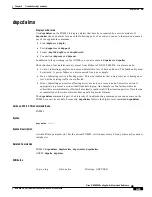
9-72
Cisco MGX 8850 Routing Switch Command Reference
Release 2.0, Part Number 78-10467-04 Rev C0, October 2001
Chapter 9
Troubleshooting Commands
dspcdstatus
dspcdstatus
Display Card Status
Displays the most serious alarms reported by a service module. The alarm information pertains to:
•
Lines
•
Ports
•
Connections
•
Feeders
•
Severity of each alarm
You can use this command to isolate the alarm source if, for example, you see that a Critical Alarm LED
is lit or just want to check the node for alarms. You can subsequently use other alarm commands to locate
the problem. Some alarm commands run on only the PXM45, and other commands run on service
modules. The commands other than dspcdstatus on the PXM45 are:
•
dspndalms displays various types of alarms on the node from a high-level perspective. With the
information in the dspndalms display, you can select one of the other commands to investigate the
alarm further.
•
dspcdalms identifies line, port, feeder, or connection alarms on an AXSM.
•
dspclkalms shows alarms related to network clocks.
•
dspenvalms lists alarms for out-of-range conditions for temperature, voltage sources, and so on.
•
dspslotalms shows card-level alarms, such as a missing card or a disk problem on the PXM-HD.
•
dspswalms shows alarms related to the switching hardware on the PXM45.
The alarm monitoring function on the PXM45 uses two criteria to determine which alarm to display. One
criterion is alarm severity, and the other is hierarchy.
The definition of each alarm severity comes from Bellcore TR-NWT-000474. An alarm can be:
•
Critical, indicating complete, non-recoverable failure, loss of data, and do on. The failed entity must
be restored. A power failure or a line being disconnected is an example.
•
Major, indicating service-affecting errors. This event indicates that a major service is damaged or
lost, but the existing traffic is not affected.
•
Minor, indicating non-service affecting errors or errors on a remote node. Corrective action is
appropriate to prevent a serious fault from developing. An example is a fan failure, where no
subscribers are immediately affected, but calamity could result if the situation persists. Note that an
accumulation of lower-level alarms does equal a higher-level alarm.
Two hierarchies of alarm types exist. They are card alarms and node alarms. See
Figure 9-2
for a list of
alarm categories. Note that, although the card alarms appear to apply to only service modules, this
category can also apply to the PXM45.
















































